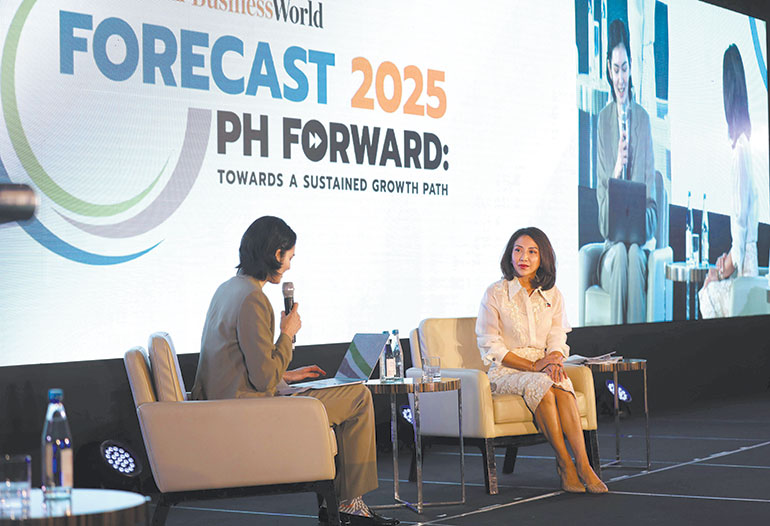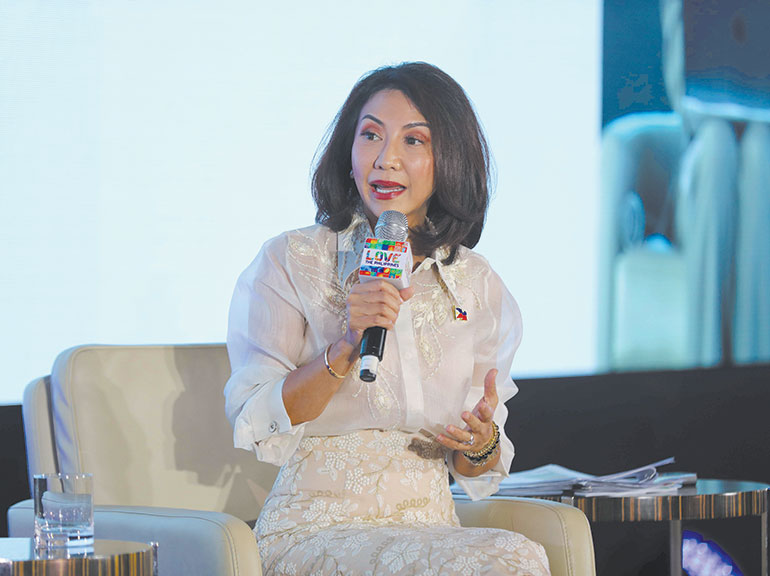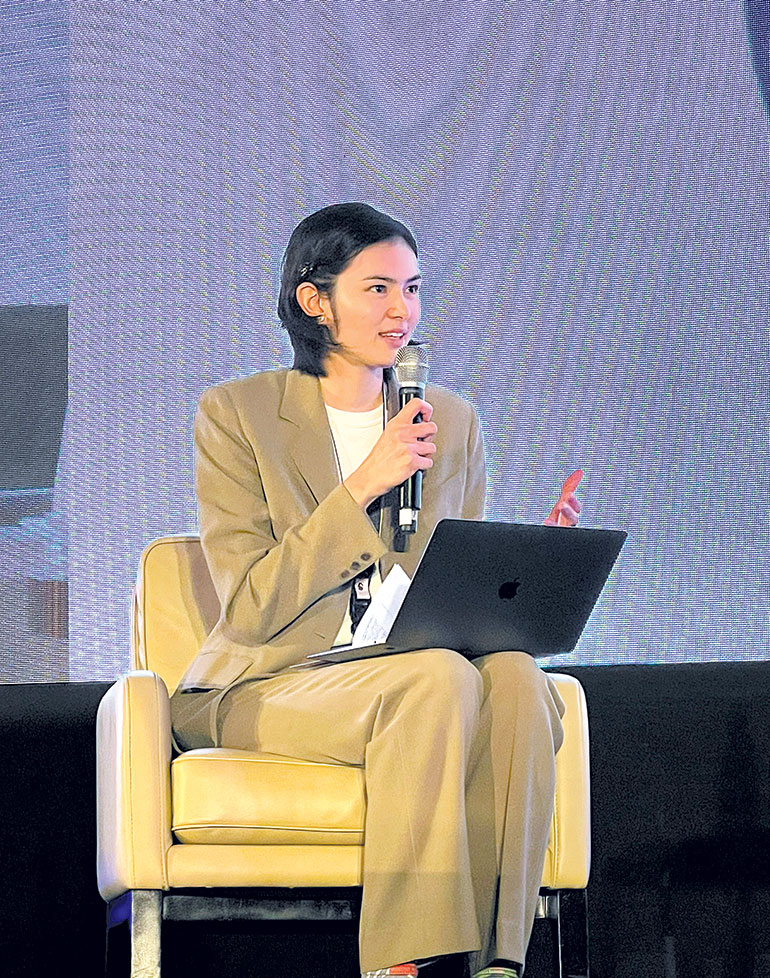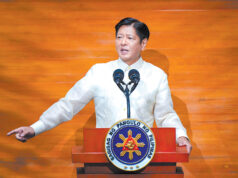PHL’s track to becoming a tourism powerhouse

By Mhicole A. Moral, Special Features and Content Writer
The contribution of tourism to the Philippine economy is expected to soar to P5.4 trillion by the end of 2024, according to the World Travel and Tourism Council (WTTC). This projection represents a 25% year-on-year growth as the sector rebounds and even surpasses pre-pandemic levels by 7.1%.
At the BusinessWorld Forecast 2025, held last Nov. 26 at the Grand Hyatt Manila, Department of Tourism (DoT) Secretary Ma. Esperanza Christina G. Frasco discussed the tourism outlook, potential challenges, and emerging trends that could affect the country’s growth.
“Tourism is not only a source of livelihood and employment for millions of Filipinos; it is most importantly a source of national pride,” said the secretary.
Currently, the DoT focuses on calculating visitor receipts and tourism employment to gauge the sector’s true impact on the economy.
“We are focusing our sights not only on the traditional perspectives of measuring tourism performance, which is in terms of international arrivals alone but from a global perspective,” Ms. Frasco explained. “At the end of the day, these two critical numbers will determine the recovery of our economy post-pandemic, as well as the opportunities for our fellow Filipinos to achieve middle-class income as envisioned by our president.”
Tourism as a national priority
The Philippines exceeded its 2019 tourism figures in 2023, with international visitors contributing over $9 billion to the economy — up from $6 billion spent by Filipinos abroad. This resulted in a trade surplus of $2.45 billion in travel services, marking the first surplus in 15 years. The country also outpaced Southeast Asia in domestic tourism, contributing over $52 billion to the region’s gross domestic product.
The impact extends to employment, with tourism now supporting over 16 million jobs, the highest in the industry’s history, according to the Philippine Statistics Authority (PSA). Tourism’s direct gross value added also recorded the highest growth rate from 2022 to 2023.
Meanwhile, visitors spending has been higher than the regional average, with tourists spending an average of $126 per night, up from the regional average of $83. Longer stays, which now average 11 nights, contribute to the economy by providing more opportunities for local businesses.
Ms. Frasco emphasized the government’s commitment to strengthening tourism as a key economic driver.

“To fully flourish, tourism needs a solid foundation built on four pillars: infrastructure; connectivity; digitalization; and a multifaceted approach to tourism that highlights culture, heritage, and community-based tourism,” she emphasized.
Infrastructure development is the first priority in the administration’s tourism strategy. The DoT has partnered with the Department of Public Works and Highways (DPWH) to construct at least 531 kilometers of roads leading to key tourist destinations, with more projects in the pipeline for 2025.
The government is giving attention to the modernization of airports as the country depends on air travel, with over 99% of international arrivals arriving by air. In addition to the ongoing privatization of Ninoy Aquino International Airport, regional airports in Bohol, Puerto Princesa, Kalibo, and the Bicol Region are set for privatization and upgrades.
Ports are also receiving attention, with new facilities and rehabilitated terminals enhancing connectivity for the Philippines’ archipelagic geography.
Furthermore, tourism infrastructure projects such as tourist rest areas, first-aid facilities, and hyperbaric chambers for diving destinations are also being developed to enhance the overall tourist experience and ensure safety and convenience.
Addressing challenges
On connectivity, the Philippines is opening new international routes, with flights from Manila to Paris and San Francisco set to begin.
Despite positive developments, challenges remain, particularly in infrastructure quality, with the Philippines ranked 75th out of 117 economies in the World Economic Forum’s 2021 report. However, the government expects improvements in the country’s global competitiveness rankings as infrastructure investments take effect.
“With these interventions being introduced by the Marcos Administration, we anticipate the ranking will vastly increase, therefore further increasing the competitiveness of the country,” the secretary noted.
On the other hand, visa policies pose a challenge. While other countries in the region have relaxed their visa requirements, the Philippines still maintains stricter visa processes. Secretary Frasco believes that adopting a more flexible visa system could boost tourism numbers, especially from countries that require visas.
“We foresee that this challenge will continue, but we are optimistic that the Department of Foreign Affairs and the Bureau of Immigration, in collaboration with the President’s office, will roll out a fully functional electronic visa travel system,” she explained.
If implemented effectively, the system could streamline travel and attract more visitors from countries that require visas, ultimately boosting tourism numbers.
“The President articulates his vision of tourism transformation in that he used the Philippines as a tourism powerhouse in Asia, on the strength of heritage, our culture, and our Filipino identity, and driven by the principles of sustainability, resilience, and inclusivity,” she added.
Diversifying tourism offerings
While the Philippines has long been associated with “fun and adventure,” the DoT is expanding its offerings to showcase the country’s rich cultural heritage, diverse traditions, and local craftsmanship.
“Our heritage, culture, food, and traditions are facets of the community tourism industry that we are now focusing on,” Ms. Frasco noted.

At the same time, the DoT is focusing on promoting the country’s heritage with projects aimed at fostering community tourism. An example of this is the allocation of P255 million through the Tourism Champions Challenge for local government units to develop sustainable, community-based tourism infrastructure, including a project in Bolinao, Pangasinan.
The government also continues to ensure sustainability in the sector through collaboration with dive operators and stakeholders, following the country’s position as the World’s Leading Dive Destination, with around 120 dive destinations nationwide.
Beyond traditional leisure and beach tourism, the government has launched the Philippine Experience Program, which focuses on promoting the country’s rich culture, history, and heritage. With a focus on lesser-known regions, the program offers tourists opportunities to explore the nation’s festivals, gastronomy, and local traditions. This initiative is already operating in over 22 provinces.
“With all of these things that we are instituting, we’re hopeful that we can further increase the visitor’s span, have longer stays, provide more quality tourism, and increase tourism employment,” said the secretary.



